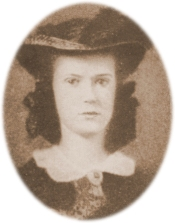

Sarah Morgan and a family member whom she never met, Mary Chestnut, are the best known female diarists of the war. Morganís entries are considered to be far more insightful than those written by others, and the first five and six volumes written during the conflict are the most revealing. She faithfully reported activities of the more common individuals and became an early supporter of womenís rights.
Born into a wealthy New Orleans family, Sarah Morgan was the daughter of an influential judge who moved his family to Baton Rouge when Sarah was eight. Morgan began her diary in 1862 at age 20. Because of her wealth, she was keenly aware of social status, but soon learned that the war demanded a greater degree of tolerance than antebellum period. Her own family became divided, as some broke from regional loyalty to support the North.
When Yankees captured New Orleans in 1862, Morgan was a first impressed with civility of the Union officers, but when Baton Rouge experienced the same fate, her attitude changed dramatically. In her diary she wrote that the city was "barely noticeable." Ransacked by the blue-clad soldiers, her familyís home, she wrote, "was the most shockingly treated house in the town." She added, "I could hardly believe that Abraham Lincolnís officers had really come so low down." Morgan and her widowed mother were forced to move back to New Orleans, where in 1864 they learned that two of her brothers died of disease in Confederate ranks.
Morgan never returned to Baton Rouge, and her hatred for the Yankees lasted the rest of her life. In 1874 she married Frank Dawson, a newspaper owner, and she noted that "marriage is not the end of a woman." Dawson died 10 years later, leaving Morgan with two children. In her later years, Morgan moved to Paris, where she died on May 5, 1909. Her remains were interred at St. Lawrence Cemetery in Charleston, and her diaries were originally printed in 1913 under the title, The Civil War Diaries of Sarah Morgan.